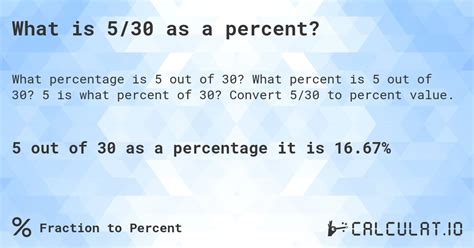What Percentage Is 5 Of 30
Kalali
Mar 29, 2025 · 4 min read

Table of Contents
What Percentage is 5 of 30? A Comprehensive Guide to Percentage Calculations
Understanding percentages is a fundamental skill applicable across various aspects of life, from calculating discounts and sales tax to comprehending financial reports and statistical data. This comprehensive guide delves into the question, "What percentage is 5 of 30?", providing a step-by-step explanation, practical examples, and exploring related concepts to solidify your understanding of percentage calculations.
Understanding Percentages: The Basics
A percentage is a way of expressing a number as a fraction of 100. The term "percent" literally means "per hundred" or "out of 100." It's a versatile tool for comparing proportions, representing changes, and presenting data in a readily understandable format. The symbol % represents the percentage.
For instance, 25% means 25 out of 100, which can also be written as the fraction 25/100 or the decimal 0.25.
Calculating "What Percentage is 5 of 30?"
To determine what percentage 5 represents of 30, we'll use a straightforward formula:
(Part / Whole) * 100% = Percentage
In this case:
- Part: 5 (the number we want to express as a percentage)
- Whole: 30 (the total number)
Let's plug these values into the formula:
(5 / 30) * 100% = Percentage
-
Divide the part by the whole: 5 / 30 = 0.166666...
-
Multiply the result by 100%: 0.166666... * 100% = 16.67% (approximately)
Therefore, 5 is approximately 16.67% of 30.
Different Methods for Calculating Percentages
While the above method is the most common and straightforward, let's explore a couple of alternative approaches:
Method 2: Using Proportions
We can also solve this problem using proportions. We set up a proportion where x represents the unknown percentage:
5/30 = x/100
To solve for x, we cross-multiply:
30x = 500
x = 500 / 30
x ≈ 16.67
Therefore, 5 is approximately 16.67% of 30.
Method 3: Using Decimal Conversion
First, convert the fraction 5/30 into a decimal:
5 ÷ 30 = 0.166666...
Then, multiply the decimal by 100 to express it as a percentage:
0.166666... * 100% ≈ 16.67%
Again, we arrive at the same answer: approximately 16.67%.
Practical Applications: Real-World Examples
Understanding percentage calculations is crucial for various real-world scenarios. Let's explore a few examples:
Example 1: Sales and Discounts
A store offers a 20% discount on an item originally priced at $30. To calculate the discount amount, we find 20% of $30:
(20/100) * $30 = $6
The discount is $6, and the final price after the discount is $30 - $6 = $24.
Example 2: Test Scores and Grades
If you answered 15 out of 20 questions correctly on a test, what percentage did you achieve?
(15/20) * 100% = 75%
You achieved a score of 75%.
Example 3: Financial Calculations
Suppose you invested $100, and your investment grew to $115. To calculate the percentage increase:
(($115 - $100) / $100) * 100% = 15%
Your investment increased by 15%.
Example 4: Statistical Analysis
In a survey of 100 people, 30 said they prefer Brand A. What percentage of people prefer Brand A?
(30/100) * 100% = 30%
30% of the surveyed people prefer Brand A.
Beyond the Basics: Advanced Percentage Concepts
While calculating a simple percentage like "What percentage is 5 of 30?" is foundational, let's explore some more advanced concepts:
Percentage Increase and Decrease
Calculating percentage changes involves finding the difference between two values and expressing it as a percentage of the original value.
- Percentage Increase: [(New Value - Original Value) / Original Value] * 100%
- Percentage Decrease: [(Original Value - New Value) / Original Value] * 100%
Compound Interest
Compound interest involves earning interest on both the principal amount and accumulated interest. It's a powerful concept in finance and investments.
Percentage Points vs. Percentages
It's important to distinguish between percentage points and percentages. A change of 10 percentage points is different from a 10% increase.
Tips and Tricks for Mastering Percentage Calculations
- Practice regularly: The more you practice, the more comfortable you'll become with percentage calculations.
- Use a calculator: Calculators can efficiently handle complex percentage calculations.
- Understand the concepts: Don't just memorize formulas; understand the underlying logic.
- Break down complex problems: Divide large problems into smaller, more manageable steps.
- Check your work: Always verify your calculations to avoid errors.
Conclusion
Understanding percentages is a vital skill for navigating various aspects of daily life. Knowing how to calculate percentages accurately and efficiently can help you make informed decisions in finance, education, and many other areas. This guide has explored the question, "What percentage is 5 of 30?" in detail, providing multiple methods and practical examples to solidify your understanding. By mastering these concepts, you'll be well-equipped to tackle more complex percentage-related problems with confidence. Remember to practice regularly and utilize the tips and tricks provided to enhance your skillset.
Latest Posts
Latest Posts
-
Cuanto Es El 10 De 3000
Apr 01, 2025
-
How Many Centimeters Is 38 In
Apr 01, 2025
-
How Many Inches Is 116 Cm
Apr 01, 2025
-
What Is Meant By The Term Saturated When Describing Hydrocarbons
Apr 01, 2025
-
Is Toasting A Marshmallow A Chemical Change
Apr 01, 2025
Related Post
Thank you for visiting our website which covers about What Percentage Is 5 Of 30 . We hope the information provided has been useful to you. Feel free to contact us if you have any questions or need further assistance. See you next time and don't miss to bookmark.
